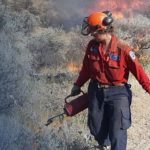Home »

Little relief in store for western drought
Likely a late start for ski/snowboard season
For those of you who believe the fire ban will be lifted soon, because it is mid-August, you best think again.
AccuWeather Global Weather Centre August 19 reported that warm and generally dry weather will continue to dominate across much of Western Canada into the fall, bringing little in the way of relief to areas that are dealing with drought and high wildfire danger.
“Warm and unusually dry conditions have persisted during the 2015 growing season from southwestern British Columbia to Alberta due in part to abnormally warm water over the northeastern Pacific and a stubborn high pressure system anchored along the west coast,” AccuWeather reported today.
“This type of pattern is expected to be the dominant pattern into the fall, which will lead to a continuation of warmer and drier conditions as Pacific storms and Arctic fronts are detoured away from the region. Expect a higher-than-usual number of days in excess of 30 degrees Celsius (86 F) away from the coast into early October.
“The 2015-2016 ski and snowboard season will likely get off to a late start across the higher elevations of Western Canada due to a lack of late-autumn snow and sustained cold,” AccuWeather predicted.
The East Kootenay is currently in stage three drought conditions; one stage away from being in a complete drought.
El Nino continues to intensify over the equatorial Pacific, and we expect this current episode to be one of the strongest El Ninos on record by the upcoming winter. The main impacts for Canada from this El Nino should be felt from late fall through winter across Canada.
Strong El Ninos typically produce unusually mild winters across Western Canada. Farther east, the impacts are less certain but tend to favor reduced snowfall around the Great Lakes region.
Current indications are that this upcoming winter will not be nearly as cold as last winter across Eastern Canada.
e-KNOW







